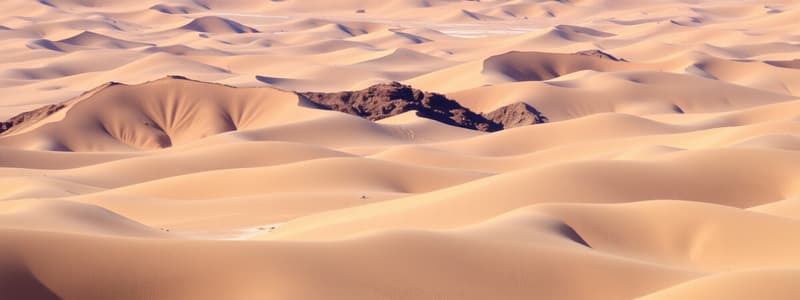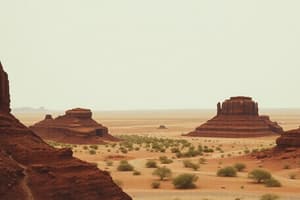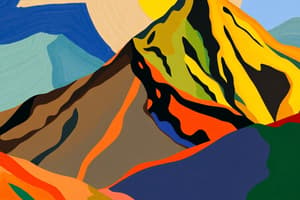Podcast
Questions and Answers
What is a desert?
What is a desert?
A desert is defined as a geographic area where annual rainfall is less than 10 inches (25 centimeters) or where the potential evaporation rate exceeds the precipitation rate.
How are semi-arid areas defined?
How are semi-arid areas defined?
A semi-arid area is defined as a geographic area where annual rainfall is 10-20 inches/year.
What criteria are used to classify deserts?
What criteria are used to classify deserts?
Deserts are classified based on differences in general geographic location and atmospheric circulation patterns.
Which of the following are characteristics of subtropical deserts (Hot)?
Which of the following are characteristics of subtropical deserts (Hot)?
What defines continental deserts?
What defines continental deserts?
What are rainshadow deserts?
What are rainshadow deserts?
What are coastal deserts?
What are coastal deserts?
What defines polar deserts?
What defines polar deserts?
List and define 4 desert landforms related to weathering and mass wasting.
List and define 4 desert landforms related to weathering and mass wasting.
What master soil horizon is found in arid and semi-arid climate zones, but not in other climate zones?
What master soil horizon is found in arid and semi-arid climate zones, but not in other climate zones?
What type of material is found at the base of most buttes and mesas?
What type of material is found at the base of most buttes and mesas?
List and define 2 desert landforms related to deposition by streams.
List and define 2 desert landforms related to deposition by streams.
List and define 2 desert landforms related to erosion by streams.
List and define 2 desert landforms related to erosion by streams.
List and define 2 wind erosion processes and 2 landforms resulting from these processes in arid lands.
List and define 2 wind erosion processes and 2 landforms resulting from these processes in arid lands.
Flashcards are hidden until you start studying
Study Notes
Definition of Deserts
- Deserts receive less than 10 inches (25 cm) of annual rainfall, or have evaporation rates exceeding precipitation.
Semi-arid Areas
- Characterized by annual rainfall ranging from 10 to 20 inches (25 to 51 cm).
Classification of Deserts
- Classified based on geographic location and atmospheric circulation patterns.
Types of Deserts
Subtropical Deserts (Hot)
- Extensive deserts located between latitudes 20° and 30°.
- Examples: Sahara, Arabian, Thar, Great Australian Deserts.
Continental Deserts (Hot)
- Found in continental interiors, far from moisture sources with hot summers and cold winters.
- Examples: Gobi, Taklamakan, Turkestan, Karakum Deserts.
Rainshadow Deserts (Hot)
- Created by mountain ranges blocking moist air, leading to low precipitation on the leeward side.
- Examples: Sonoran, Mojave, Chihuahuan, Great Basin Deserts, Patagonia Desert.
Coastal Deserts (Hot)
- Located along continents' margins where cold seawater cools air flowing onshore.
- Examples: Atacama, Peruvian, Namib, Kalahari Deserts.
Polar Deserts (Cold)
- Characterized by very low precipitation due to sinking cold air and underlain by ice.
- Examples: Northern Greenland, Siberia, Dry Valleys of Antarctica.
Desert Landforms Related to Weathering and Mass Wasting
- Plateau: Extensive flat-topped highlands, resistant to weathering; much larger than a mesa.
- Mesa: Large isolated flat-topped land, resistant to erosion; larger than a butte.
- Butte: Medium-sized isolated flat-topped hill, smaller than a mesa.
- Pinnacle/Pedestal Rock: Small steep-sided hills formed from eroded buttes, capped by erosion-resistant rock.
K-Horizon
- A master soil horizon unique to arid and semi-arid climate zones, absent in other climates.
Talus
- Material commonly found at the base of buttes and mesas.
Desert Landforms Related to Deposition by Streams
- Alluvial Fans: Fan-shaped deposits forming where streams exit steep mountain valleys.
- Bajadas: Broad fans formed by the coalescing of multiple alluvial fans.
Desert Landforms Related to Erosion by Streams
- Pediments: Gently sloping surfaces cut into bedrock, extending from mountain fronts.
- Inselbergs: Isolated hills or mountains rising abruptly from surrounding plains.
Wind Erosion Processes and Landforms
- Deflation: Removal of sand and dust by wind.
- Desert Pavement: Coarse surface layer formed from the deflation process, consisting of closely packed rock fragments.
Studying That Suits You
Use AI to generate personalized quizzes and flashcards to suit your learning preferences.





